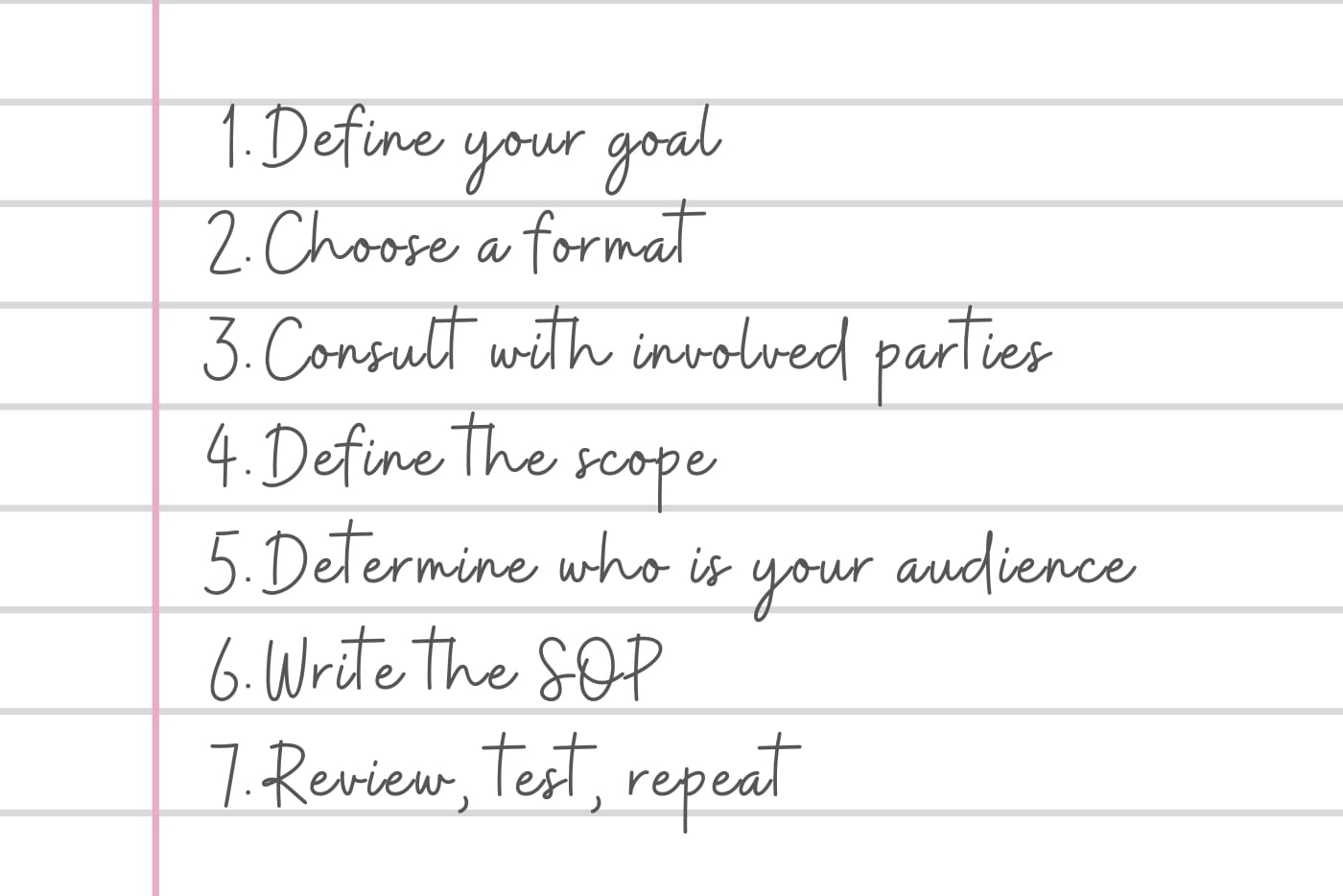Working on an SOP? This is your go-to guide.
Determining a playbook for your internal activities is the best way to ensure business continuity, operational efficiency, and the best possible services for your customers. But not all organizations have explanatory documents in place, leading to repetitive tasks, human error, and overlooked steps that could save time and money.
This is when Standard Operating Procedures come into place.
What is a Standard Operating Procedure (SOP)?
According to Chron, a Standard Operating Procedure is a way to increase your odds of performing consistent, high-quality work.
“A Standard Operating Procedure, or SOP, is a document that provides step-by-step instructions on how to perform a particular business activity. These can be activities such as manufacturing or record keeping”.
Although most SOPs are presented as text documents, they can also contain images or videos to help clarify their instructions, they explain.
A few areas that can highly benefit from well-written Standard Operating Procedures are:
CUSTOMER ONBOARDING
A consistent customer onboarding process is one of the most important Standard Operating Procedures you’ll create as a company. When creating the document, make sure to be as detailed as possible to ensure all parties have a great understanding of what customer onboarding entails.
63% of customers consider the company’s onboarding program when making a purchasing decision.
Automate your Customer Onboarding and follow your SOP every single time

MARKETING PROCESSES
Whether your company’s focused on creating awareness through sophisticated email campaigns or simply developing creative captions for your social media platforms, an SOP can help your team members follow step-by-step instructions.
By having a written document that fosters uniformity, you will not only make the process easier but will also result in better, more engaging marketing efforts.
Writing an SOP for your marketing department? This will help you.
SALES OPERATIONS
Chron has shared that sales SOPs are steps that standardize routine sales functions. The goal is that each employee involved in the sales process performs the sales functions the same way every time.
Creating an SOP for your sales team will streamline sales processes and improve their performance. Giving them proven steps they need to follow each time. Leaving no room to improvisation, but providing them with a solid, verified manual on how to achieve the results.
HUMAN RESOURCES ACTIVITIES
Human resources can benefit from Standard Operating procedures in areas pertaining to benefits, compensation, pre-employment, employment, and separation. At a high level, this will save your HR team time and money and improve your internal culture while reducing liabilities.

Great Employee Onboarding can improve employee retention by 82%
Onboard employees smoothly no matter where they are. Automate and Digitize your HR!
INTERDEPARTMENTAL PROCEDURES
A healthy company culture promotes open channels of communication. To encourage this, interdepartmental transparency can be achieved through easily accessible SOPs that clearly stated processes followed by accounting, finance, IT, etc.
By ensuring every department puts an emphasis on creating standard operating procedures, you’re fostering a positive and open culture for your employees. While making sure processes run smoothly and employees know what to do and where to go every single time.
» By automating your interdepartmental processes you are facilitating compliance with your SOPs.
This also simplifies your employee onboarding, as they don’t need to learn complex processes. Instead, you can design your processes based on your SOPs. The software later, will guide the users and will trigger events automatically.
These are some of the departments and industries for which Virtus Flow has automated and created process templates:
Human Resources
I. T.
Manufacturing
Vendor Management
Customer Support
Financial Services
Purchasing
Healthcare
Facility Management
Regardless of the process, the main benefits of an SOP are:
〉Ensuring compliance
〉Maximizing production
〉Ensuring safety
〉Adhering to a schedule
〉Training and onboarding
DOWNLOAD YOUR SOP CHECKLIST FOR FREE
How to Write a Standard Operating Procedure
You now understand how important and beneficial SOPs are, so how do you get started? Here’s your step-by-step guide.

1. Define your goal
The first thing when writing an SOP is to determine what business process you will be describing, who will benefit from this document, and how it’ll benefit the team when performing a task.
If it’s a customer onboarding SOP, for instance, why is it important for your team to understand how to onboard new clients? Have there been issues in the past that led you to develop this SOP? What’s your expected outcome?
2. Choose a format
Determining the SOP format that best works for the process you’re describing is key. Common SOPs usually follow a simple steps format, a hierarchical steps format, or a flowchart.
The flowchart format is great for intricate processes that could throw many different outcomes. Whereas the first two tend to be more simple and can be easier to follow. You’ll have to decide which one conveys the information more clearly.
3. Consult with all involved parties
A good SOP can take a long time to develop, but if you’re making sure that all involved parties are actively involved, you’ll have a much more robust document. While considering a broader amount of resources and potential outcomes.
If you’re developing an SOP to explain how marketing leads will be transferred to the sales team, make sure to involve representatives from both departments.
4. Define the scope
You already know that your SOP is a procedural document that helps the reader fulfill a task in a successful way, but it is not uncommon to see SOPs that rely on other documents or even other SOPs for clarity.
When writing the SOP it’s important to take a step back and make sure to have a 360-degree view of your project.
5. Define your audience
Who are you writing the SOP for? Are they seasoned employees who have a great understanding of how things work at your company, or are they recent graduates who are learning how to conduct business as new employees?
Answering all these questions will help you to be specific, which will help the reader to understand how to complete the tasks they are expected to own.
6. Write the SOP
Even though you should keep your SOP simple and straight to the point, being organized is key. A few things you should always include are a title page, a table of contents, and a detailed description of the procedures. Also include relevant terminology and necessary resources to fulfill them successfully.
7. Review, test, repeat
When we write Standard Operating Procedures, it is expected to have many drafts and ongoing editing sessions. We have even seen companies use this document in a more dynamic way, altering the processes as they discover new ways to accomplish goals.
A good idea is to develop SOP templates you can continue to reuse and replicate for other processes. This will help you to save time and money.

Make sure your employees comply with your SOPs at all times…
Automate your processes and standardize operations!




